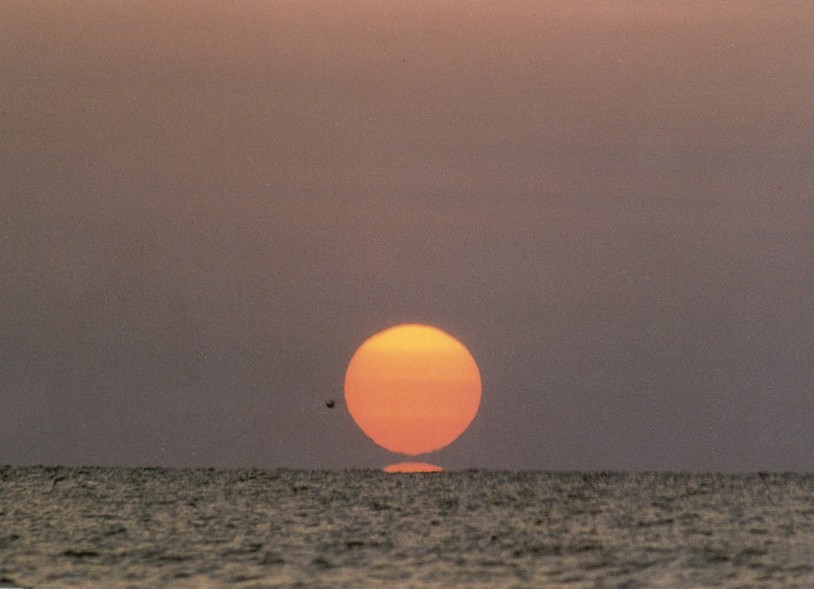
The inferior mirage is very clearly shown in a series of sunset images taken by George Kaplan, of the U. S. Naval Observatory. Here, I describe what's seen in these images, which used to be on the Naval Observatory's website. They are such a “textbook example” of the inferior-mirage sunset that I begged for some details, and permission to show the images here.
I've taken the liberty of showing his photographs in this page repeatedly, to illustrate points shown by the different images.
First, there's the “reflection” of the lower limb of the Sun that appears at the horizon:

This is actually not a reflection in the ocean, but the miraged (inverted) image of the Sun's lower edge. A few seconds later (notice the motion of the bird to the left of the Sun!), the reflection fuses with the erect image:
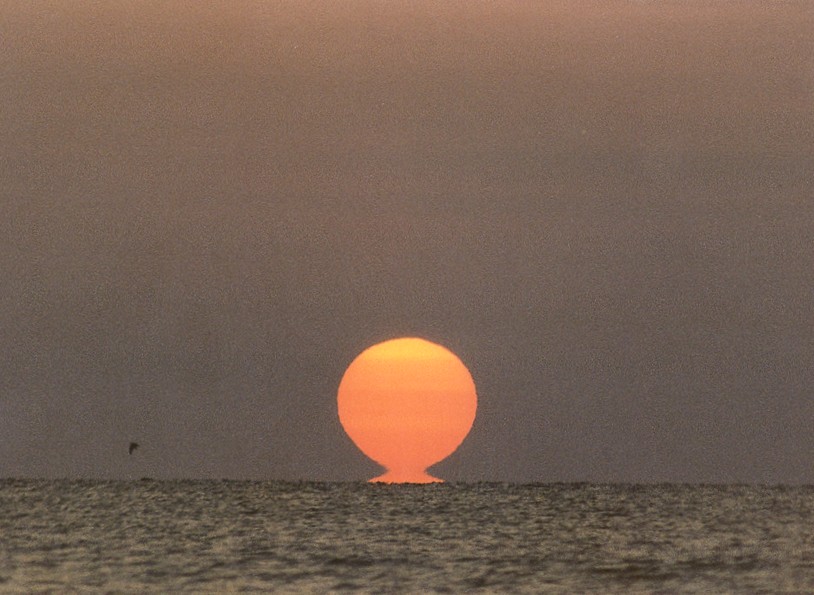
Here you can plainly see the line, a little above the apparent horizon, where the image “folds over” from the erect image above the line to the inverted image below it. Notice that the image is not sharply creased at this fold, but that the indentations at the foot of the Sun — the base of Jules Verne's “Etruscan vase” — are smoothly curved. That's because the image is vertically stretched there.
In fact, the stretch is infinite just at the “fold line”. It is this vertical stretching that makes the green flash (when there is one) visible to the naked eye; without the stretch, the green rim would be too narrow to see without magnification. (Alas, this sunset was too hazy to allow the green rim to be seen, so no flash was recorded.)
After a few more seconds, the reflection forms a pair of “feet” at the lower corners of the image. These give the whole image a shape like the capital Greek letter Omega:
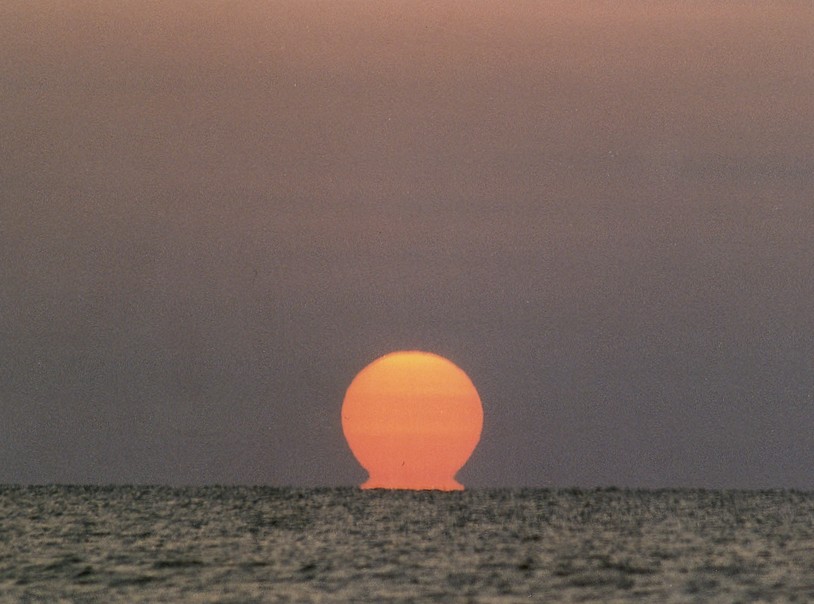
Notice that the “fold line” remains at a fixed altitude above the horizon as the Sun sinks down.
About 2 minutes later, the upper edge of the Sun is approaching the horizon, and we see the upper limb miraged:

The lower edge of the “football shape” is the inverted image of the upper part. Again, notice the rounded ends, at the fold line.
Now that you've seen the pictures, let's compare them with a simulation of an inferior-mirage sunset. George Kaplan says the camera was 4 or 5 feet above the water; that's about 1.4 meters. I've done a simulation for that height, using my standard inferior-mirage temperature profile. Instead of displaying the sequence as a movie, I've picked the individual frames that look most similar to the actual photographs — which I've scaled to match the size of the simulations. Here are the comparisons:

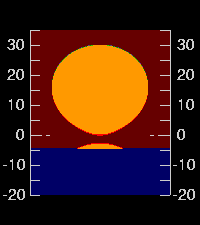
By a lucky coincidence, scaling the pictures to the same size as the simulations has made the apparent horizons nearly coincide. As in the movies, the vertical scales in the simulations are graduated in minutes of arc.


Here's the “Omega”:

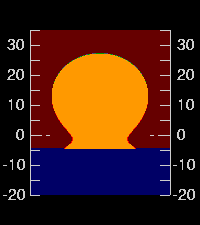
Evidently, the simulations are close, but not perfect. They show a little more of the inferior mirage; that is, the apparent horizon is a little lower, relative to the Sun, in the simulations.

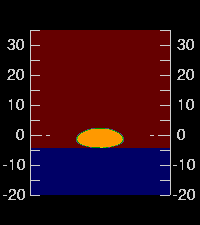
If the sky had been clearer, a green flash would have followed this stage in 5 or 10 seconds. You can't see the green rim in the photographs, largely because the haze made it too faint, and the sky too bright. However, the hazy sky allowed the photographer to capture details of the apparent horizon that are worth pointing out.
Look again at the fine structure of the apparent horizon in these pictures. In the one just above, you can see that the waves — which are primarily horizontally-oriented details in the foreground — become little vertical features just at the horizon itself. The other pictures show this, too (compare the shallow wave slopes in the foreground with the structure at the horizon). This jagged apparent horizon has too much vertical structure to be the profiles of waves.
The apparent horizon in the inferior mirage looks strange because it is actually the boundary between the mirage and the foreground. Small temperature fluctuations at the wave crests cause this boundary to be closer to the observer in some places, and farther away in others. The dip of the apparent horizon increases with the temperature of the air where the lowest ray grazes the water surface: the warmer the air where the waves cut off the sky beyond, the lower this boundary appears (see the paper on the dip diagram for details.)
The horizon looks even stranger in motion than it does in these still images. Ferguson says that
At about the same time, the astronomer John Franklin-Adams saw an inferior-mirage flash broken into “beads” by this effect, which he compared to “Baily's Beads” in solar eclipses, and commented:Even when neither land nor ships are in sight, the miraging can be determined by the unique moving appearance of the horizon seen through a telescope. The water seems to wave unnaturally and seems to flicker like flames along the upper surface. It does this with a strongly increased dip.
Likewise, Fullagar and Meade, seeing a distant vessel miraged, noticed that... the phenomenon here described may have been caused by the waves of the sea taking the place of the mountains of the Moon. The evening was calm, and the waves not large enough to make this possible unless images of the waves were thrown up by a mirage state of the atmosphere. I have twice seen from a steamer's deck mirage images of the sea waves, about a mile distant, thrown up sufficiently to entirely hide the horizon.
As the vessel drew closer the fo'c'sle, masts and accommodation appeared to hover above the horizon, seemingly separated from the rest of the vessel, which could not be observed at the time. Although the sea was calm with only small ripples, the waves at the horizon appeared magnified.
Speaking of the waves, you'll notice that they're fairly low here. In fact, the small wave height is responsible for the large amount of solar mirage that's visible in these pictures. The average wave height determines how close you can see to the average water level at the apparent horizon, where the mirage begins. The lower the waves, the closer you can see to the warm water, and the more the apparent horizon is depressed.
Anyone who is used to looking at sunsets over the ocean will be impressed with how much of the inferior mirage is seen here. On the ocean, the waves are usually much higher, and the inferior mirage is less obvious. You almost never see as much of a “pedestal” in the Etruscan-vase stage as you do here:

The secret of success in this case was to take pictures over a narrow body of water (Albemarle Sound), not the open ocean. The photograph was taken from Nags Head, North Carolina, in August, 1999. The Sound is only about 20 km wide, so the “fetch” or available distance for the wind to generate waves is small; consequently, the waves there are much smaller than on the open sea under similar wind conditions.
In the first 3 images, notice how much brighter the Sun is at the top than at the bottom. In fact, the yellow part at the top of each image is slightly overexposed; it should really be about the same orange hue as the lower portions (as you can see from the very edge of the upper part of each image, where the overexposed image bleeds into the sky and reveals its true color). This brightness gradient over the disk is due to differential extinction: you're seeing the lower parts through much more atmosphere than the upper parts, even though they are only half a degree apart in the sky.
The air mass in the line of sight increases in proportion to the refraction near the horizon — a law discovered by Laplace. But, in hazy conditions such as we see here, the extinction increases even more steeply toward the horizon, because most of the extinction is due to boundary-layer aerosols, which are confined to a much thinner layer than the atmosphere as a whole.
These aerosols have a patchy distribution, which is partly responsible for the faint horizontal lines crossing the Sun. As the camera here is so close to sea level, the astronomical horizon is just above the fold line in the image; so these features cannot be actual “layers” below eye level and seen tangentially. Nor, as the inferior mirage shows that the surface layer is convective, are there likely to be inversions overhead with waves on them. So we're left with highly foreshortened irregular patches of haze as the most likely explanation of the faint horizontal streaks crossing the Sun, and in the sky above it.

One more comment about the extinction: there's a lot of it here. Compare the hazy sunset above with a clear one I took to illustrate an inferior-mirage flash:
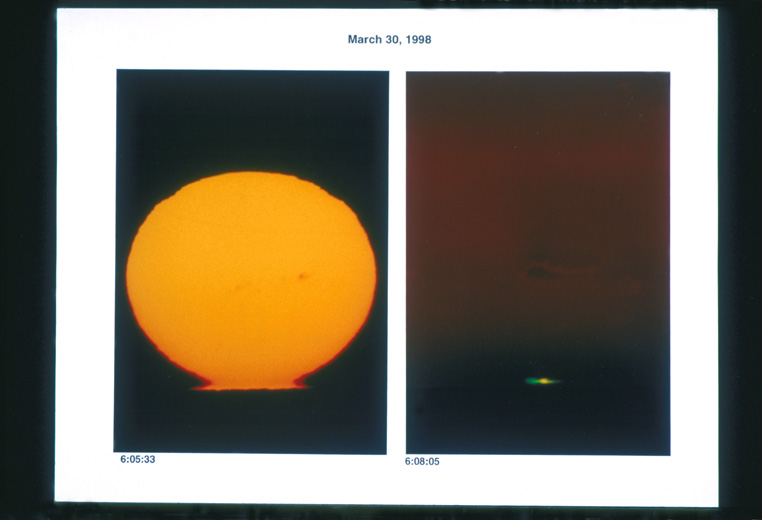
In George Kaplan's pictures, you can see the sky and the foreground water plainly. That's because there was so much extinction that the Sun was dim, and he had to increase the exposure to get the Sun correctly exposed. But in my pictures, the air was clear, and the Sun was much brighter. I had to cut back several stops to keep the Sun from being overexposed; and the result was that the sky and the sea went black, from extreme underexposure. (In both cases, the foreground is illuminated mainly by sky light from overhead, which is nearly the same in both his pictures and mine.)
You'll also notice much less gradient across the face of the Sun in my picture, and no horizontal streaks — all signs of a very clear sky. These are useful clues for the would-be green-flash observer; you soon learn which sunsets look promising, and which are not.
Notice that the sky, like the Sun, is brighter at the top of each picture than at the apparent horizon. But ordinarily, the daytime sky is brightest near the horizon. So what causes this reversal of the normal brightness gradient in the sky?

It's the same extinction that produces the similar gradient across the Sun. When the Sun is this low, nearly all the sunlight has been scattered out of the direct beam in the upper atmosphere, leaving only a few millionths of the normal brightness of the Sun's disk (which is how the photographs can show the Sun and the foreground almost equally well exposed). The brightly-lit upper atmosphere then acts like a diffuse light source. Its light is attenuated by the extinction in the lower atmosphere — which is mostly in the low haze.
As there's more of this extinction near the horizon than higher in the sky, the sky is darkened more by the foreground (i.e., lower-atmosphere) extinction near the horizon than higher up.
One more thing worth noticing in the pictures is something you don't see: the glitter path on the water, leading from the eye to the Sun. When the Sun is higher in the sky, the glitter on the water is prominent. But when it's this low, the path vanishes. (If you watch sunsets over water, you'll see that the glitter begins to fade about 10 minutes before sunset. It slowly pulls back from the horizon toward you, and finally disappears at the shoreline a few minutes before sunset.)
When you look at the water near the horizon, you typically see wave facets tilted toward you by 10 or 15 degrees. (The horizontal parts at the tops of the waves are so foreshortened at the horizon that they contribute negligibly to the projected area.) These facets reflect what's in the sky 20 or 30 degrees above the horizon. Just a few facets, which are greatly reduced in size by foreshortening, reflect parts of the sky 2 or 3 degrees above the horizon.
But the Sun is 2 or 3 degrees above the horizon about 10 minutes before sunset. (Remember that it takes 4 minutes, at low latitudes, for the Sun to move a degree.) As the Sun gets lower than that, there's hardly any wave surface visible at the horizon with the proper shallow slope to reflect it. However, if you look down into the water close to shore, you begin to look over the tops of nearby waves, and see an appreciable amount of wave surface with the right slope. So there's still a little glitter left just in front of you, but none at the horizon.
But all these pictures were taken with telephoto lenses, with small fields of view (remember that the width of the Sun is not appreciably affected by refraction, and is about half a degree). So these pictures can't show any glitter at the photographer's feet. Besides, who's going to be looking down at his feet with a beautiful sunset out there at the horizon anyway?
© 2003 – 2007, 2010, 2021 Andrew T. Young